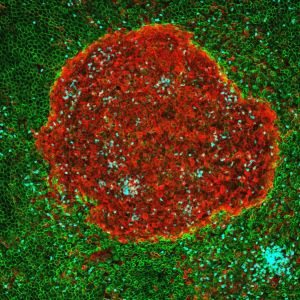María López-Bravo, codirectora del trabajo junto a Ardavín en el CNB-CSIC, apunta: “durante la sepsis peritoneal, los macrófagos eliminan las bacterias y este proceso se asocia con la formación de agregados multicelulares en el mesotelio que cubre la cavidad peritoneal”.
En este trabajo, mediante técnicas de microscopía confocal y citometría de flujo, “hemos caracterizado en detalle estas estructuras, y las hemos denominado resMØ-aggregates (del inglés: “resident macrophage aggregates”). “Estos agregados, que contienen también linfocitos B y neutrófilos, son estructuras dinámicas cruciales para controlar las infecciones en la cavidad peritoneal, ya que crean un microambiente en el que las células pueden realizar sus funciones antimicrobianas”.
Adrian Vega-Pérez y Laura Hernández Villarrubia, coautores del trabajo, explican cómo estas estructuras dependen de la formación de una red de fibrina (una proteína fibrosa que forma, junto con las plaquetas, los coágulos sanguíneos) por activación de un proceso de coagulación extravascular, controlado por las células mesoteliales que cubren la cavidad peritoneal. Una vez controlada la infección, los macrófagos peritoneales participan en la eliminación de células muertas presentes en el interior de los agregados, y contribuyen a la desintegración de éstos por un proceso de fibrinólisis (degradación de la fibrina para deshacer los coágulos sanguíneos).
Ardavín destaca el cambio en la localización de los macrófagos, que en condiciones normales se encuentran libres en el fluido peritoneal, y pasan a formar los agregados, proporcionando así un soporte que facilita la interacción y la función de las células inmunitarias. Además, “la relevancia de la presencia de estas estructuras en la cavidad peritoneal abre un nuevo paradigma sobre la organización del sistema inmune de las diferentes cavidades corporales, y sugiere que podrían existir estructuras similares a las descritas en otras cavidades como la cavidad pleural o los ventrículos cerebrales con un papel crucial en la defensa frente a infecciones, un conocimiento clave para el desarrollo de nuevas terapias”.
Más información
Vega-Pérez A, Villarrubia LH, Godio C, Gutiérrez-González A, Feo-Lucas L, Ferriz M, Martínez-Puente N, Alcaín J, Mora A, Sabio G, López-Bravo M, Ardaví. Resident macrophage-dependent immune cell scaffolds drive anti-bacterial defense in the peritoneal cavity. Immunity. DOI: 10.1016/j.immuni.2021.10.007
CNB-CSIC Comunicación






